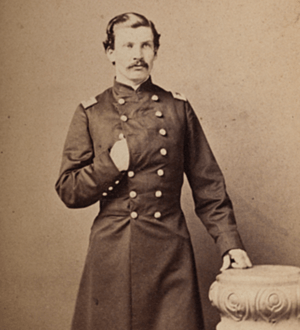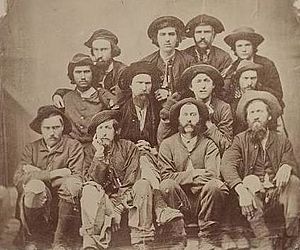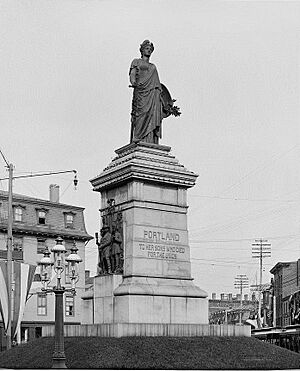Charles Mattocks facts for kids
Quick facts for kids
Charles P. Mattocks
|
|
|---|---|
 |
|
| Born | October 11, 1840 Danville, Vermont |
| Died | May 16, 1910 (aged 69) Portland, Maine |
| Place of burial |
Evergreen Cemetery (Portland, Maine)
|
| Allegiance |
|
| Service/ |
|
| Years of service | 1862–1865, 1898 |
| Rank | Brevet Brigadier general |
| Unit | 17th Maine Volunteer Infantry Regiment |
| Battles/wars | |
| Awards | Medal of Honor |
| Alma mater |
|
| Spouse(s) | Ella Robbins |
| Children | Margaret, Mary |
| Signature | |
Charles Porter Mattocks (born October 11, 1840 – died May 16, 1910) was a brave colonel in the Union Army during the American Civil War. He received the Medal of Honor, which is the highest award for bravery in the U.S. military. Charles was born in Danville, Vermont. He fought with the 17th Maine Infantry. During the war, he was captured and held as a prisoner of war for nine months. After the war, he became a brigadier general and led the Maine State Militia. He also served during the Spanish–American War. Besides his military career, he was a lawyer and a politician. He was elected to the Maine House of Representatives and argued a case in the Supreme Court.
Contents
Early Life and Education
Charles Mattocks was born in Danville, Vermont, on October 11, 1840. His father, Henry Mattocks, was a merchant and banker. Sadly, Henry died when Charles was only three years old. Charles's mother, Martha, later remarried and moved the family to Baldwin, Maine.
Charles went to school at Phillips Academy in Massachusetts and Lewiston Falls Academy in Maine. In 1858, he started college at Bowdoin College in Maine. He graduated in 1862. While at Bowdoin, he was part of student groups and studied public speaking and German. One of his teachers was Joshua Chamberlain, who later became a famous Civil War general.
In 1861, when the American Civil War began, Charles helped form a student military group called the "Bowdoin Guards." He commanded this group. Many students joined, showing their support for the Union. Charles, along with his teacher Joshua Chamberlain and many other students, joined the Union Army in the summer of 1862.
Military Service in the Civil War

After graduating from college in 1862, Charles Mattocks joined the Union Army. He became a lieutenant in the 17th Maine Volunteer Infantry Regiment. His regiment fought in many big battles with the Army of the Potomac. These battles included Fredericksburg, Chancellorsville, and the Appomattox Campaign.
Charles kept a journal from 1863 to 1865, writing about his experiences. In the Battle of Chancellorsville, his company lost many soldiers. A general praised Charles and his company for their "gallant conduct." In the Battle of Gettysburg, his regiment again suffered heavy losses. Charles wrote to his mother that the two men standing next to him were killed.
In 1864, Charles was given command of the 17th Maine Infantry as a major for two months. Later, he led the 1st United States Sharpshooters. During the Battle of the Wilderness, he was captured by the Confederate Army. He was a prisoner for six months.
Escape and Return to Duty
On November 3, 1864, Charles Mattocks escaped from a Confederate prison camp in South Carolina. He escaped with two other officers from Maine. They walked for two days without food. They received help from a slave who gave them food. They also got help from other soldiers while in prison and during their escape.
However, Charles was recaptured close to Union lines. He was forced to walk over 100 miles to another prison camp in Virginia. He was finally released in February 1865. Instead of going back to his old command, he rejoined the 17th Maine Infantry as a major. He fought near Petersburg, Virginia. After Petersburg fell, Charles led his regiment in the Appomattox Campaign. He was especially brave leading a charge at the Battle of Sailor's Creek. This was his last battle of the Civil War.
Three days later, on April 9, 1865, Confederate General Robert E. Lee surrendered. Charles Mattocks was promoted to brevet colonel for his actions at Sailor's Creek. He also received the Medal of Honor in 1899 for his bravery in that battle. He was fully promoted to colonel on May 15, 1865. He left the army on June 4, 1865.
In 1867, President Andrew Johnson nominated Charles Mattocks to be a brevet brigadier general for his "faithful and meritorious services" during the war.
Medal of Honor Award
On April 6, 1865, Major Mattocks led his regiment in a charge during the Battle of Sailor's Creek. His regiment had 220 men. They captured two enemy flags, two cannons, about 300 prisoners, and a loaded supply wagon. For this act of bravery, he was awarded the Medal of Honor on March 29, 1899.
Key Military Milestones
- Joined the army as a first lieutenant on July 31, 1862.
- Promoted to captain on December 4, 1862.
- Promoted to major on December 22, 1863.
- Captured at the Battle of the Wilderness on May 5, 1864.
- Released from being a prisoner of war on March 22, 1865.
- Promoted to lieutenant colonel and then to Colonel of the 17th Maine on May 9, 1865.
- Left the army on June 4, 1865.
Other Military Roles
After the Civil War, Charles Mattocks joined the Maine State Militia in 1868. He became a captain. In 1879, he was promoted to colonel, leading all the infantry (foot soldiers) in Maine.
During the Spanish–American War in 1898, Charles served as a Brigadier General of Volunteers in the United States Army. He was ordered to command regiments in Georgia. However, the war ended before he could take part in any fighting. On October 7, 1898, he was honorably discharged. This happened because the army was made smaller after the war.
Life After the War
After the Civil War, Charles Mattocks studied law at Harvard Law School. He graduated in 1867. In 1871, he married Ella R. Robinson in Portland, Maine. He then opened his own law office in Portland. From 1870 to 1873, he served as the county attorney for Cumberland County, Maine. He even argued a case in front of the Supreme Court of the United States in 1882.
Charles also owned a large farm in Baldwin, Maine. He was very active in groups for Civil War veterans, like the Grand Army of the Republic. He was also a Freemason.
He helped create the Our Lady of Victories monument in Portland. This monument honors soldiers and sailors from Portland who died in the Civil War. In 1880, Charles was elected to the Maine House of Representatives as a Republican. He served there for four years. In 1900, he became a judge for Cumberland County.
World's Columbian Exposition
In 1893, Charles Mattocks was the main representative from Maine for the World's Columbian Exposition in Chicago. This was a huge world's fair. He was in charge of designing and building Maine's special building for the fair. The building was unique, made from granite and slate donated by Maine quarrymen.
Death and Legacy
Charles Mattocks passed away in Portland, Maine, on May 16, 1910. He was buried with full military honors in Evergreen Cemetery. After his death, his wife received a military pension. In 1955, a scholarship was created in his name at Bowdoin College. The Brown Memorial Library in Baldwin, Maine, was also built on land that Charles Mattocks had donated.
See also
- List of American Civil War brevet generals (Union)
- List of American Civil War Medal of Honor recipients
- List of Harvard Law School alumni
- Maine in the American Civil War
Images for kids



